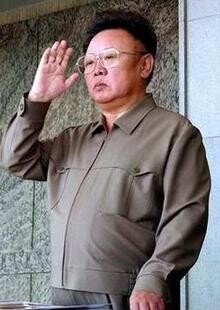hankyoreh
Links to other country sites 다른 나라 사이트 링크
[Analysis] Has Kim Jong-il pulled off another strategic disappearance?

While Kim Jong-il, North Korea’s National Defence Commission chairman, has not been seen in public since August 14, the 66-year-old leader has often shunned public appearances for lengthy periods in the past.
When stories about Kim’s health circulated in June 2007, the National Intelligence Service, South Korea’s spy agency, said in a report to the National Assembly that since the death of North Korea’s founder Kim Il-sung, who died in July 1994, Kim Jong-il had suspended his public activities on 17 separate occasions for more than 30 days each.
Since 2000, the North Korean leader has declined to appear in public for long periods at times when the North’s relations with the United States had either grown chilly or deteriorated because of a standoff over North Korea’s nuclear weapons program. After U.S. President George W. Bush took office in January 2001, Kim did not appear in public for 36 days beginning February 15 of that year, increasing speculation about a setback in Kim’s health. It was later found, however, that his absence was linked to his desire to monitor the course North Korea policy would take under the Bush administration.
In 2003, Kim was not seen in public from February 13 until April 3. At the time, North Korea announced that it was withdrawing from the Nuclear Nonproliferation Treaty following what many have called a second crisis in the North Korean nuclear issue. This was also the beginning of the U.S. invasion of Iraq. As Kim did not attend the Presidium of the Supreme People’s Assembly, the North’s parliament, in March of that year, foreign media outlets reported that Kim may have lost power and that he may have attempted to flee amid the fear that his country would be the next U.S. target after Iraq. However, it was later discovered that Kim was immersing himself in a review of geopolitical issues such as the U.S.-led war against Iraq and the simmering nuclear standoff between Pyongyang and Washington.
Immediately after North Korea test-fired missiles in 2006, Kim was not seen in public for 39 days beginning July 5. As Kim’s absence became prolonged, there were stories about an internal power struggle or a honeymoon with his fourth wife, Kim Ok. When Kim resumed his schedule of public activities following his 39-day absence, Kim played a leading role in dealing with international pressure following the missile tests and damage from a massive flood within the country that year.
Rumors of Kim’s poor health began circulating in June 2007 after Japanese media outlets reported that the North Korean leader might be sick. However, Kim appeared at a summit with then South Korean President Roh Moo-hyun that October.
“Stories about Kim Jong-il’s poor health come and go with regularity because of the closed nature of the North Korean regime, Kim’s age and chronic illnesses such as diabetes and high blood pressure,” said a South Korean government official. “Given the fact that rumors of setbacks in his heath have thus far been proven to be groundless speculation, it will be necessary to maintain a state of calm and have a cautious attitude until something serious is detected in the North.”
Please direct questions or comments to [englishhani@hani.co.kr]
Editorial・opinion
![[Editorial] Penalties for airing allegations against Korea’s first lady endanger free press [Editorial] Penalties for airing allegations against Korea’s first lady endanger free press](https://flexible.img.hani.co.kr/flexible/normal/500/300/imgdb/original/2024/0502/1817146398095106.jpg) [Editorial] Penalties for airing allegations against Korea’s first lady endanger free press
[Editorial] Penalties for airing allegations against Korea’s first lady endanger free press![[Editorial] Yoon must halt procurement of SM-3 interceptor missiles [Editorial] Yoon must halt procurement of SM-3 interceptor missiles](https://flexible.img.hani.co.kr/flexible/normal/500/300/imgdb/child/2024/0501/17145495551605_1717145495195344.jpg) [Editorial] Yoon must halt procurement of SM-3 interceptor missiles
[Editorial] Yoon must halt procurement of SM-3 interceptor missiles- [Guest essay] Maybe Korea’s rapid population decline is an opportunity, not a crisis
- [Column] Can Yoon steer diplomacy with Russia, China back on track?
- [Column] Season 2 of special prosecutor probe may be coming to Korea soon
- [Column] Park Geun-hye déjà vu in Yoon Suk-yeol
- [Editorial] New weight of N. Korea’s nuclear threats makes dialogue all the more urgent
- [Guest essay] The real reason Korea’s new right wants to dub Rhee a founding father
- [Column] ‘Choson’: Is it time we start referring to N. Korea in its own terms?
- [Editorial] Japan’s rewriting of history with Korea has gone too far
Most viewed articles
- 160% of young Koreans see no need to have kids after marriage
- 2[Editorial] Penalties for airing allegations against Korea’s first lady endanger free press
- 3Months and months of overdue wages are pushing migrant workers in Korea into debt
- 4Bills for Itaewon crush inquiry, special counsel probe into Marine’s death pass National Assembly
- 5[Reporter’s notebook] In Min’s world, she’s the artist — and NewJeans is her art
- 6[Guest essay] Maybe Korea’s rapid population decline is an opportunity, not a crisis
- 71 in 3 S. Korean security experts support nuclear armament, CSIS finds
- 8S. Korea discusses participation in defense development with AUKUS alliance
- 9Cracks found in containment building of UAE nuclear power plant built by S. Korean companies
- 10At heart of West’s handwringing over Chinese ‘overcapacity,’ a battle to lead key future industries